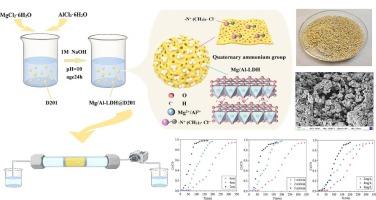Enhanced phosphate removal and recovery by Mg/Al-layered double hydroxide modified D201 resin for water treatment
IF 6.7
2区 工程技术
Q1 ENGINEERING, CHEMICAL
引用次数: 0
Abstract
A novel Mg/Al-LDH@D201 composite was synthesized by combining Mg/Al layered double hydroxide (LDH) with D201 anion-exchange resin, achieving synergistic phosphate adsorption exceeding the capabilities of individual components. This enhanced performance stems from D201's ion exchange and LDH's dual mechanisms (interlayer exchange and surface complexation), confirmed by X-ray photoelectron spectroscopy (XPS) and Fourier transform infrared spectroscopy (FTIR) analyses. Scanning electron microscopy (SEM) revealed increased surface roughness with LDH loading, indicating more adsorption sites, while X-ray diffraction (XRD) confirmed high LDH crystallinity. Batch experiments showed a high adsorption capacity (49.51 mg g−1 at 298 K), rapid kinetics, and excellent selectivity across pH = 7–8, even with competing anions (e.g., sulfate, nitrate). Fixed-bed studies assessed bed height, flow rate, and initial concentration, demonstrating effective continuous phosphate removal for wastewater treatment. Efficient regeneration (>80 % over five cycles) highlights practical potential. The synergistic interaction, enhanced surface properties, and selectivity position Mg/Al-LDH@D201 as a promising material for efficient phosphate removal and recovery from aqueous solutions. DFT calculations further supported these mechanisms by revealing strong binding affinities between phosphate species and Mg/Al-LDH@D201 surface sites.

Mg/ al层状双氢氧化物改性D201树脂对水处理中磷酸盐的去除和回收
将Mg/Al层状双氢氧化物(LDH)与D201阴离子交换树脂结合,合成了一种新型的Mg/Al-LDH@D201复合材料,实现了超过单个组分能力的协同磷酸盐吸附。这种增强的性能源于D201的离子交换和LDH的双重机制(层间交换和表面络合),并通过x射线光电子能谱(XPS)和傅里叶变换红外光谱(FTIR)分析证实。扫描电子显微镜(SEM)显示,LDH加载后表面粗糙度增加,表明吸附位点增加,而x射线衍射(XRD)证实LDH结晶度高。批量实验表明,该材料具有较高的吸附量(298 K时为49.51 mg g - 1),快速的吸附动力学,在pH = 7-8时具有优异的选择性,即使是与竞争阴离子(如硫酸盐、硝酸盐)。固定床研究评估了床的高度、流速和初始浓度,证明了废水处理中磷酸盐的有效连续去除。高效再生(5个循环80%)突出了实际潜力。协同作用、增强的表面性质和选择性使Mg/Al-LDH@D201成为一种有前途的材料,可用于有效去除和回收水溶液中的磷酸盐。DFT计算通过揭示磷酸盐物种与Mg/Al-LDH@D201表面位点之间的强结合亲和力进一步支持了这些机制。
本文章由计算机程序翻译,如有差异,请以英文原文为准。
求助全文
约1分钟内获得全文
求助全文
来源期刊

Journal of water process engineering
Biochemistry, Genetics and Molecular Biology-Biotechnology
CiteScore
10.70
自引率
8.60%
发文量
846
审稿时长
24 days
期刊介绍:
The Journal of Water Process Engineering aims to publish refereed, high-quality research papers with significant novelty and impact in all areas of the engineering of water and wastewater processing . Papers on advanced and novel treatment processes and technologies are particularly welcome. The Journal considers papers in areas such as nanotechnology and biotechnology applications in water, novel oxidation and separation processes, membrane processes (except those for desalination) , catalytic processes for the removal of water contaminants, sustainable processes, water reuse and recycling, water use and wastewater minimization, integrated/hybrid technology, process modeling of water treatment and novel treatment processes. Submissions on the subject of adsorbents, including standard measurements of adsorption kinetics and equilibrium will only be considered if there is a genuine case for novelty and contribution, for example highly novel, sustainable adsorbents and their use: papers on activated carbon-type materials derived from natural matter, or surfactant-modified clays and related minerals, would not fulfil this criterion. The Journal particularly welcomes contributions involving environmentally, economically and socially sustainable technology for water treatment, including those which are energy-efficient, with minimal or no chemical consumption, and capable of water recycling and reuse that minimizes the direct disposal of wastewater to the aquatic environment. Papers that describe novel ideas for solving issues related to water quality and availability are also welcome, as are those that show the transfer of techniques from other disciplines. The Journal will consider papers dealing with processes for various water matrices including drinking water (except desalination), domestic, urban and industrial wastewaters, in addition to their residues. It is expected that the journal will be of particular relevance to chemical and process engineers working in the field. The Journal welcomes Full Text papers, Short Communications, State-of-the-Art Reviews and Letters to Editors and Case Studies
 求助内容:
求助内容: 应助结果提醒方式:
应助结果提醒方式:


